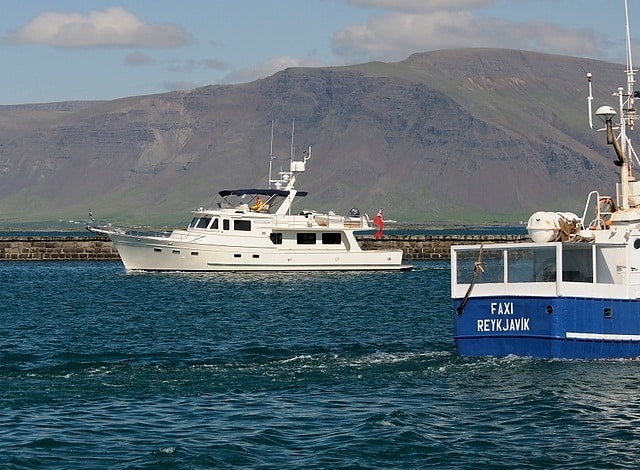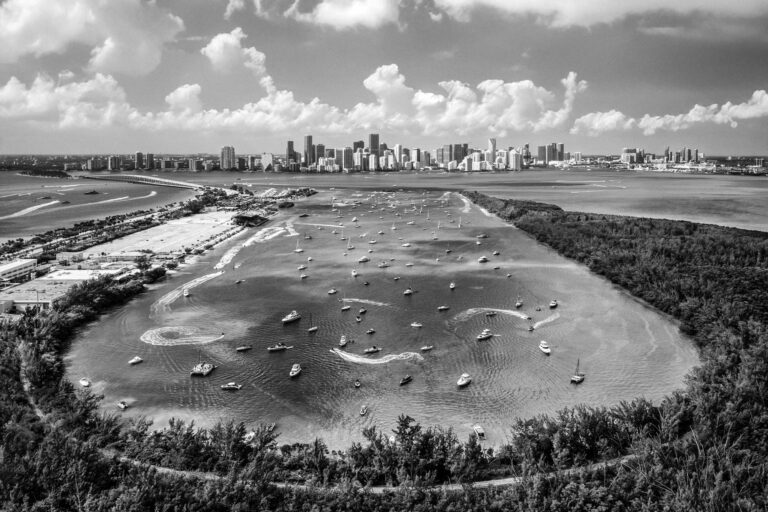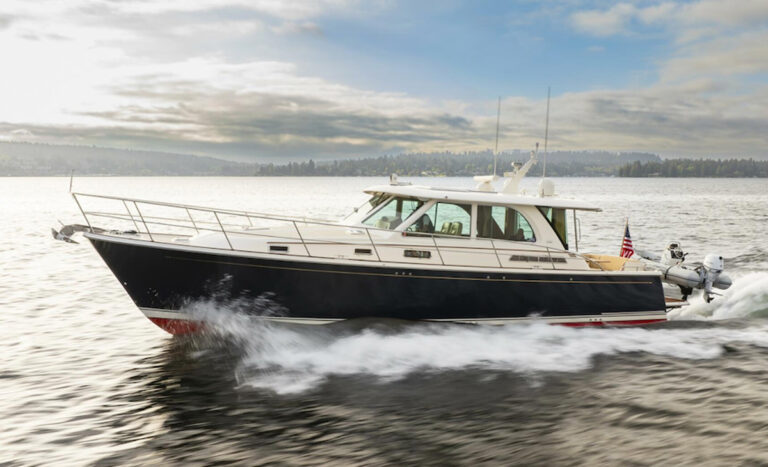
Fleming Arrives in Iceland
Our berth in Vestmannaeyjar’s harbor was along a floating dock that included a number of recreation boats and several small fishing vessels. Nearby a fleet of excursion boats ran visitors from Reykjavik to see whales, puffins and the dramatic landscapes of this island chain known as the Westman Islands.
But it was clear that we were in a major fishing port, as we were surrounded by large trawlers unloading their catch or readying their boat for their next trip in the North Atlantic waters. What we didn’t quite realize at first, thanks to a favorable wind direction and the fact that we arrived on a Sunday, was the overpowering smell from the fish processing plants that enveloped our boat and permeated into everything, including our clothing. Later that evening a large tanker arrived to unload its cargo of “black oil,” an unrefined fuel so thick it must be heated before being used in the large, slow turning diesels of the fishing fleet.
The village of Heimaey was virtually deserted on Sunday afternoon, although several people found their way to our dock to get a closer look at Venture II. Once again we had the largest pleasure boat in the harbor, and these seasoned seafaring folk were curious to know more about it. A fellow who had just returned from a family fishing outing on his 30-foot boat stopped by to give us four very large cod fish to welcome us to Vestmannaeyjar. I was elected to clean and fillet them and later prepared a delicious baked cod dinner. We still have enough frozen fish for two more dinners.
The next day we set out to explore the immediate area, eventually finding “Pompei of the North,” the name of the excavation site of several buildings consumed by the volcanic eruption of 1973. This eruption lasted five months and covered nearly one-third of the entire town. Eventually the archeologists hope to uncover part of the old town.
Chris checked the weather reports for our 130-mile passage to Reykjavik, and we decided to leave the following day. We charted a course that would first take us by the island of Surtsey, 20-miles south of Heimaey, which was created during a series of volcanic eruptions between 1963 and 1966. Declared a nature reserve in 1965, visitors are prohibited from landing, as scientists use it as a pristine laboratory to study the process of colonization of plants and animals.
Underway from the friendly but odoriferous Vessmannaeyjar harbor at 0500, we passed Surtsey at 0700, spotting the lone building housing the resident scientists. It’s hard to imagine this entire island didn’t exist until the mid 60s.
The wind was blowing a steady 25 knots and the seas were running 5-feet on top of the ocean swell, but fortunately they were behind us. Venture II’s autopilot and stabilizers did their job superbly, keeping us steady and on track, averaging 10-knots. It was a welcome change from the bashing we took three days before. As we ran 4-miles off Iceland’s southern coast we spotted the general area of Eyjafjallajökull (don’t even attempt to pronounce it) where the most recent volcano erupted, causing extensive damage to farmers because of floods and ash fallout and sending its ash to contaminate Europe’s airspace. By now it was obvious to us that Iceland is still a “young” island country, with which Mother Nature has not yet finished.
At 1400 we rounded the southwest point of Iceland, turning north towards Reykjavik, and by 1800 we were tied up downtown at the floating dock of the Brokey Yacht Club. Again, we were by far the largest yacht, as most of the boats at the club were 25 to 35-foot sailboats. There really wasn’t enough room for us, as our forward section projected 20-feet beyond the end of the dock. But it was good enough to spend the night, and we figured we would inquire about finding a more suitable berth the next day.
The four of us felt quite a sense of accomplishment watching the busy scene in Reykjavik Harbor for hours, as the sun doesn’t set here until midnight and rises three hours later. Based on the few pleasure boats we’ve seen, and particularly the absence of any sizeable powerboats, cruising to Iceland is major undertaking. Most powerboats we’ve seen in Europe (except for the very large superyachts) are really not capable of making such a voyage, as their range and self-sufficiency are not up to the task.
Tony Fleming began this 2,200-mile journey in April, leaving Southampton, England to explore the Scottish Isles before heading to Iceland. Much like his 20,000-mile voyage on VENTURE I from Alaska to Nova Scotia (with a side trip to the Galapagos Islands), he enjoys visiting out-of-the-way destinations and spending enough time to experience the many different cultures he discovers along his route. He documents his exciting travels by shooting and producing high quality, informative, high definition videos, which are available as DVDs on Fleming’s web site, www.flemingyachts.com.
With a new crew arriving in a week, Tony and Chris are planning to circumnavigate Iceland before heading back to Scotland, eventually arriving in the U.K. in time for the Southampton Boat Show in early September. Tony’s recites his mantra nearly every day, “If you love boating, go now. We’re not getting any younger, boats are not getting any cheaper, and the economic conditions are not going to get much better.”
I couldn’t have said it any better and are already planning my next cruise aboard my own boat as soon as I return home to the States.
– from Reykjavik, Iceland aboard Venture II by George Sass, Sr.








